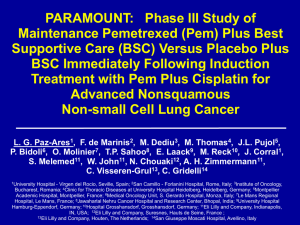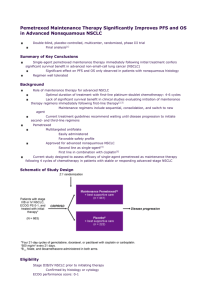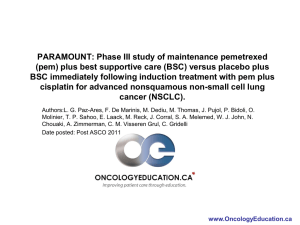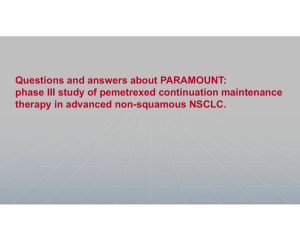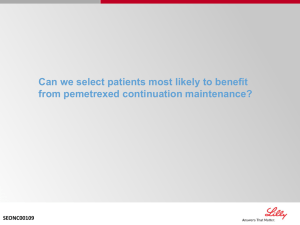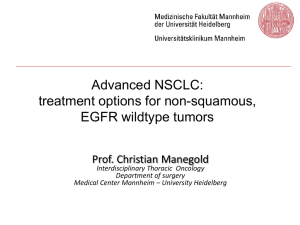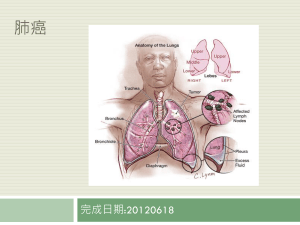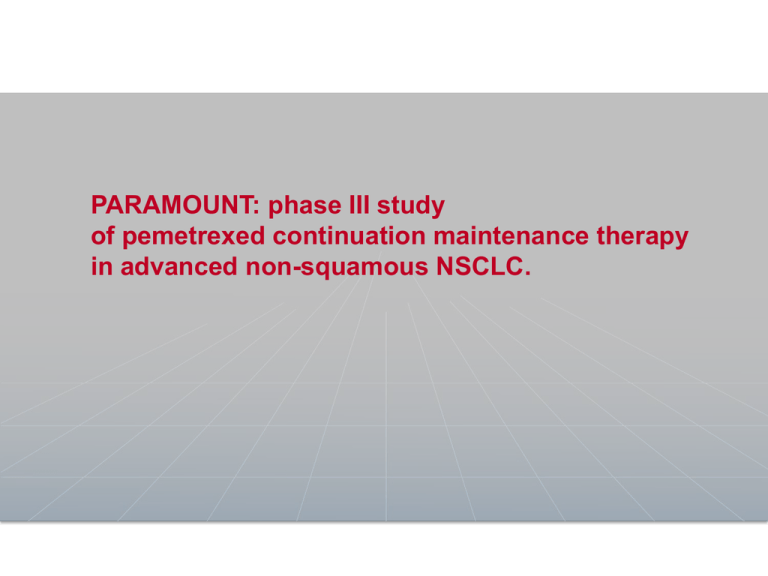
PARAMOUNT: phase III study
of pemetrexed continuation maintenance therapy
in advanced non-squamous NSCLC.
All Chapters at a glance: please click on box to review
1
2
Maintenance strategies
in non-squamous NSCLC
4
3
PARAMOUNT:
study design
and objectives
5
PARAMOUNT:
PFS results
PARAMOUNT:
patient & disease
characteristics,
drug administration
6
PARAMOUNT:
post-discontinuation
therapy
7
PARAMOUNT:
safety & tolerability
PARAMOUNT:
conclusions
Increase
the duration
of disease control
Objectives of
maintenance
therapy1
Maintaining
tolerability
Improve
overall survival
Tolerance to
maintenance
drug is known
from induction
treatment
Potential
advantages
of continuation
maintenance
approach2–4
Saves
a drug for
subsequent
treatment
lines
Maximise
the potential
of the drug used
in 1st-line
CR, PR, or SD after 4 cycles
of pemetrexed/cisplatin
n=539
pemetrexed 500 mg/m2 IV +
cisplatin 75 mg/m2
day 1, q 21 days; n=939
Patients enrolled
if:
Non-squamous* NSCLC patients only
• non-squamous* NSCLC
• no prior systemic treatment for lung cancer
• ECOG PS 0/1
progressive disease
2:1 randomisation
PARAMOUNT: pemetrexed/cisplatin followed by
pemetrexed for advanced non-squamous* NSCLC1
pemetrexed†
500 mg/m2 IV + BSC
day 1, q 21 days; n=359
placebo† + BSC
day 1, q 21 days; n=180
Stratified for:
• PS (0 vs 1)
• disease stage (IIIB vs IV) prior to induction
• response to induction (CR/PR vs SD)
*Adenocarcinoma, large cell carcinoma and other histologies
† Vitamin B12, folic acid and dexamethasone given during induction therapy and in both maintenance arms.
BSC=Best Supportive Care
PARAMOUNT: study objectives1
Primary
objective
Secondary
objectives
• Progression-free survival (PFS)
• Overall survival (OS)
• Objective tumour response rate (RR) (RECIST 1.0)
• Patient-reported outcomes (EQ-5D)
• Resource utilisation
• Adverse events (AEs)
PARAMOUNT: patient characteristics
(randomised patients)1
Median age, yrs
Age <65 yrs
Male
Caucasian
Smoker
Ever smoker
Never smoker
ECOG PS
0
1
2/3*
*Protocol violations
pemetrexed
n=359
placebo
n=180
61
62
238
201
339
339
(66%)
(56%)
(94%)
112
112
171
(62%)
(62%)
(95%)
275
82
(77%)
(23%)
144
34
(80%)
(19%)
115
243
1
(32%)
(68%)
(<1%)
55
123
2
(31%)
(68%)
(1%)
PARAMOUNT: disease characteristics
(randomised patients)1
pemetrexed
n=359
Disease stage IV*
Histology
Adenocarcinoma/bronchoalveolar
Large cell
Other non-squamous
Best tumour response to induction
CR/PR
SD
PD/Unknown†
* Lung Cancer Staging System Version V
† Protocol violations
placebo
n=180
328
(91%)
161
(89%)
310
310
24
25
(86%)
(7%)
(7%)
160
12
8
(89%)
(7%)
(4%)
166
186
7
(46%)
(52%)
(2%)
76
94
10
(42%)
(52%)
(6%)
PARAMOUNT: drug administration
(randomised patients)1
mean # of cycles
patients > 6 cycles
dose intensity
pemetrexed
n=359
4.9
23%
95%
placebo
n=180
4.2
14%
n.a.
Data related to the primary endpoint (PFS) data analysis. Figures are likely to change at the time of the final OS analysis.
Pemetrexed continuation maintenance demonstrated
significant PFS benefit for patients1
pemetrexed + BSC (n=359)
placebo + BSC (n=180)
1.0
Progression-free survival (%)
NOT reflected in the data endpoints
Induction = 4 cycles
of pemetrexed/cisplatin
Investigator-assessed PFS
0.9
0.8
HR=0.62 (95% CI 0.49–0.79); p<0.0001
0.7
0.6
2.8
4.1
HR 0.62
0.5
Median PFS (95% CI)
reduction in the
Pemetrexed 4.1 (3.2-4.6)
risk of progression
Placebo 2.8 (2.6-3.1)
38%
0.4
0.3
0.2
0.1
0
0
3
6
9
Time (months)
BSC=Best Supportive Care
12
15
Pemetrexed continuation maintenance demonstrated
significant PFS benefit for patients1
pemetrexed + BSC (n=316)
placebo + BSC (n=156)
1.0
Progression-free survival (%)
NOT reflected in the data endpoints
Induction = 4 cycles
of pemetrexed/cisplatin
Independently reviewed PFS†
0.9
0.8
HR=0.64 (95% CI 0.51–0.81); p<0.0002
0.7
0.6
2.6
3.9
HR 0.64
0.5
Median PFS (95% CI)
Pemetrexed 3.9 (3.0–4.2)
Placebo 2.6 (2.2–2.9)
0.4
0.3
0.2
0.1
0
0
3
6
9
Time (months)
† 88% of patients were independently reviewed (472/539); BSC=Best Supportive Care
12
15
Progressionfree survival
HRs in
subgroups1
N
HR (95% CI)
539
0.62 (0.59-0.79)
IIIB
50
0.55 (0.24-1.26)
IV
489
0.62 (0.49-0.80)
CR/PR
242
0.48 (0.34-0.67)
SD
280
0.74 (0.53-1.04)
0
170
0.53 (0.35-0.79)
1
366
0.67 (0.50-0.90)
Non-smoker
116
0.41 (0.24-0.71)
Smoker
419
0.70 (0.53-0.90)
Male
313
0.74 (0.55-1.00)
Female
226
0.49 (0.34-0.72)
447
0.69 (0.54-0.90)
≥70
92
0.35 (0.20-0.63)
<65
350
0.70 (0.53-0.94)
≥65
189
0.51 (0.34-0.75)
471
0.62 (0.49-0.80)
Large Cell Carcinoma
36
0.39 (0.14-1.07)
Other
32
0.64 (0.22-1.89)
All
Stage
Induction response
Pre-randomisation ECOG PS
PFS results were internally
consistent; benefit was seen
across all subgroups
Smoking status
Sex
Age (years)
<70
Histology
Adenocarcinoma
0
0.2
0.4
0.6
0.8
Favours pemetrexed
1
1.2
1.4
1.6
1.8 2.0
Favours placebo
PARAMOUNT: median PFS according to response
to induction treatment1
Response to induction treatment
Complete/Partial
response
pemetrexed (n=166)
n=242, HR=0.48,
(0.34-0.67)
placebo (n=76)
Stable disease
pemetrexed (n=186)
n=280, HR=0.74,
(0.53-1.04)
4.1 (3.1-6.0)
2.6 (1.6-2.9)
4.1 (3.0-4.6)
3.0 (2.8-4.1)
placebo (n=94)
0
1
2
3
Survival time (months)
Numbers in brackets are the 95% CI values.
4
5
PARAMOUNT: post-discontinuation therapy
(PDT-eligible patients)1
Patients with PDT
Drug name
Erlotinib
Docetaxel
Gemcitabine
Investigational drug
Vinorelbine
Bevacizumab
Cisplatin
Other†
pemetrexed
n=200
placebo
n=122
116
(58%)
78
(64%)
(64%)
0.35
62
58
15
10
8
3
3
13
(31%)
(29%)
(8%)
(5%)
(4%)
(2%)
(2%)
(7%)
45
43
4
4
2
1
1
6
(37%)
(35%)
(3%)
(3%)
(2%)
(<1%)
(<1%)
(5%)
0.33
0.27
0.15
0.58
0.33
1.00
1.00
–
p-value
† Systemic therapies administered to 1% or fewer patients in both groups are summarised under “Other”. These
therapies included carboplatin, pemetrexed, BIBF 1120, paclitaxel, placebo, aspirin, aflibercept, cyclophosphamide,
gefitinib, ifosfamide, vinflunine, and other antineoplastic drugs.
Maintenance therapy with pemetrexed:
generally well tolerated1
Overall, toxicity was low in both arms
pemetrexed
n=359
placebo
n=180
Patients with ≥ 1 grade 3/4/5
laboratory toxicity
9%*
<1%*
n=33
n=1
Patients with ≥ 1 grade 3/4/5
non-laboratory toxicity
9%
4%
n=32
n=8
* Difference between treatment groups was significant (Fisher’s exact test p ≤0.05).
PARAMOUNT: CTCAEs grade 3/4/5 drug-related
toxicities (randomised patients)1†
Anaemia
4%* n=16
<1%* n= 1
Fatigue
4%* n=15
<1%* n= 1
Neutropenia
4%* n=13
0%* n= 0
Infection
1% n=4
1% n=2
Leucopenia
2% n=6
0% n=0
Pain
1% n=3
0% n=0
Thrombocytopenia
1% n=4
0% n=0
Neuropathy
<1% n=1
<1% n=1
0
10
20
30
0
10
20
30
pemetrexed
placebo
(n=359)
(n=180)
* Difference between treatment groups was significant (Fisher’s exact test p≤0.05).
† Adverse events were reported using Common Terminology Criteria for Adverse Events version 3.0 (NCI 2006)
Alanine aminotransferase, Nausea, Vomiting, Mucositis or Stomatitis, Oedema, Anorexia, Diarrhoea, Watery eye,
Constipation Grade 3/4/5 adverse events were reported for less than 1% of patients.
PARAMOUNT: health-related quality of life
assessment (EQ-5D)1
• Compliance at all time points during
maintenance phase was >80%
• No statistical differences in EQ-5D index
score or visual analog scale were observed
between treatment arms
• EQ-5D results suggest that patients can
tolerate long-term maintenance treatment with
pemetrexed while maintaining their QoL
PARAMOUNT: conclusions1,10
• Pemetrexed continuation maintenance therapy offers significantly
PARAMOUNT
demonstrates a positive
improved PFS
•
risk/benefit ratio for the administration of
Pemetrexed continuation maintenance therapy is well tolerated1,10
pemetrexed
continuation maintenance
Pemetrexed continuation maintenance therapy:
approach to maximise outcomes for patients1,2
Proven efficacy
✔
Acceptable toxicity
✔
Conveniently administered
✔
Keeps other treatments available
✔
Acknowledgements
We thank all of the patients and their caregivers
for participating in this trial.
References
1.
Paz-Ares L et al. Maintenance therapy with pemetrexed plus best supportive care versus placebo plus best supportive care after
induction therapy with pemetrexed plus cisplatin for advanced non-squamous non-small-cell lung cancer (PARAMOUNT): a double-blind,
phase 3, randomised controlled trial. Lancet Oncol 2012; 13:247-255
2.
Stinchcombe TE, Socinski MA. Treatment paradigms for advanced stage non-small cell lung cancer in the era of multiple lines of
therapy. J Thorac Oncol 2009;4:243–50.
3.
Novello S et al. Maintenance therapy in NSCLC: why? To whom? Which agent? J Exp Clin Cancer Res 2011;30:50.
4.
Fidias P, Novello S. Strategies for prolonged therapy in patients with advanced non–small-cell lung cancer. J Clin Oncol. 2010;28:511623.
5.
Azzoli CG, Temin S, Aliff T, et al. 2011 Focused Update of 2009 American Society of Clinical Oncology Clinical Practice Guideline
Update on Chemotherapy for Stage IV Non-Small-Cell Lung Cancer. J Clin Oncol. 2011 Sep 6.[Epub ahead of print].
6.
D’Addario G, Felip E. Non-small-cell lung cancer: ESMO clinical recommendations for diagnosis, treatment and follow-up. Ann Oncol
2009;20:iv68–iv70.
7.
National Comprehensive Cancer Network. NCCN Clinical Practice Guidelines in Oncology: Non-Small Cell Lung Cancer V.3.2011. Fort
Washington, PA: NCCN, 2011.
8.
Scagliotti GV et al. Phase III study comparing cisplatin plus gemcitabine with cisplatin plus pemetrexed in chemotherapy-naive patients
with advanced-stage non-small-cell lung cancer. J Clin Oncol. 2008;26:3543-51.
9.
Ciuleanu T et al. Maintenance pemetrexed plus best supportive care for non-small-cell lung cancer: a randomized, double-blind, phase 3
study. Lancet 2009;347:1432-40.
10.
ALIMTA Summary of Product Characteristics. Eli Lilly and Company Limited. November 2011.

